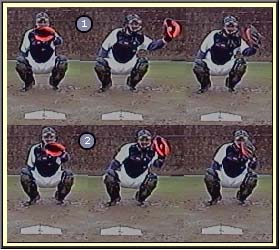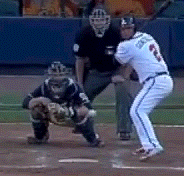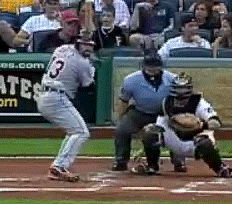Diamond Demo: Lucroy's catching
02/26/13 | 00:04:36
Brewers catcher Jonathan Lucroy talks with MLB Network about how he frames pitches and places his feet when crouching behind the plate
Lucroy talks about the footwork behind the plate and framing. A 4 1/2 minute catching clinic. "Just catch the ball and stop it" - Catching 101. Below there are some great articles from Baseball Prospectus on the issue of catchers framing. This gets more and more attention from baseball announcers and the entire instant replay crowd. So in the interest of fairness you can read some observations from a MLB umpire on how he views framing.
The catchers mentioned in the articles like Lucroy and Jose Molina of the Rays are worth their weight in gold. They will have a job even if the hit .225 because of what they bring to the defensive side.
The main thing is to receive the ball "quietly", without a lot of movement. No pulling or jerking pitches "back into the strike zone", you know what that tells everyone in the ballpark. Catchers are selling the location as acceptable to the umpires and umpires are selling the call to the other 50,000+ umpires at the ballpark. That's how the game works.
What is left unsaid in almost every analysis EXCEPT that of the MLB umpire below is that, in the umpires mind, the decision of ball-or-strike has been made BEFORE all of this so-called framing or selling goes on. But try to sell THAT to the instant replay fanatics.
from Baseball Prospectus:
Baseball Prospectus | Spinning Yarn: Removing the Mask Encore Presentation:
by Mike Fast
September 24, 2011
Exaggerated glove and body movements are well known to be distracting to umpires. As Brent Mayne wrote in The Art of Catching:
Simply catch the ball firmly. When the pitch and glove meet, that’s where the action should stop. The catcher should have enough strength to stop the momentum of the ball so that strikes don’t turn into balls. Think of a gymnast “sticking” a landing. Just “stick” the ball, hold it for a brief second, then throw it back.
Catcher Receiving Techniques Having covered the derivation and accuracy of the measurement, let us turn to the question of what catchers are doing to gain or lose a strike call. Are there mechanical differences in technique between the best and worst catchers?I selected two of the best catchers—Jose Molina and Jonathan Lucroy—and three of the worst catchers—Ryan Doumit,Jorge Posada, and Jason Varitek—and reviewed video of their borderline pitch calls. I observed two primary differences in technique between the good and bad catchers.Both Molina and Lucroy displayed stable, quiet mechanics when receiving borderline pitches. Posada was the opposite, often jumping, bouncing, and shifting his stance and lunging and swiping to catch pitches. It was almost painful to watch him behind the plate. Varitek and Doumit had more stable stances, but each displayed a negative behavior that appeared to cost them strike calls. (Posada displayed both of these negative traits, and more.)It is worth mentioning that one should not compare receiving mechanics on curveballs to mechanics on other pitch types, as was done in this analysis of Lucroy. Catchers typically set up with a different stance on curveballs to prepare to block a possible pitch in the dirt. Curveballs also drop much faster from the front of the plate to the catcher’s glove than other pitch types do. (The numbers reported above include all pitch types, but one potential improvement would be to look at receiving numbers for curveballs separately, though the smaller sample size could be a challenge.)Let’s compare Varitek to Lucroy. According to my metric, Varitek cost the Red Sox about 16 runs by losing 101 expected strike calls in part time duty over the last two seasons. Lucroy took over the starting job for the Brewers in the middle of the 2010 season and has gained about 41 runs by getting 284 extra strike calls since then.Lucroy got extra strikes for his pitchers both on the bottom and outside edges of the strike zone. Varitek did not get these same calls for his pitchers. Let’s see how they compared in 2011 on calls to right-handed batters.
Lucroy’s glove moved a few inches at most, but Varitek’s glove traveled about two feet down and then back up.I also reviewed video of 10 pitches caught by Jose Molina along the outside edge of the zone to left-handed batters and 12 pitches caught by Doumit in similar locations. Eight of ten pitches received by Molina were called strikes, and 10 of 12 pitches received by Doumit were called balls. Let’s see how they compared in 2011 on calls to left-handed batters:
'via Blog this'
Matt Lucroy C - Gonzalez Hitter
Jason Varitek C - Ben Zobrist Hitter
===
May 21, 2013
BP Unfiltered
Former MLB Umpire Jim McKean on Catcher Framing
http://www.baseballprospectus.com/article.php?articleid=20623Jim McKean worked as an MLB umpire from 1973-2001, serving on three World Series crews. He became one of MLB’s umpire supervisors after retiring from active duty and has since served as an umpiring consultant for ESPN. He offered his thoughts on the influence a catcher’s receiving skills can have on an umpire’s calls.On catcher framing: "Everybody says, ‘Oh, he’s a good framer, he’s a bad framer,’ and that’s just an entertainment word. It’s just, he caught the ball correctly. And what I mean by that is if he catches the low pitches with his palm up, so the ball comes up, catches the high pitch down, catches the outside pitches with the fingers turned in. But catching the ball correctly means the steadiness of the glove. As long as the ball is received steadily with a strong hand, then it’s a lot easier to see the pitches. And every time they do that and they go ‘Oh, he’s a good framer,’ well, no, he’s just catching the pitch correctly. That’s just my interpretation. And I was in the big league for about 30 years, so I’ve seen all sorts of catching, and good catching will make it easier for umpires to call more strikes.”On whether he preferred calling pitches behind catchers with good receiving skills: "Lots of times, you want to work, obviously, behind catchers who catch the ball correctly. And if you want to use that word ‘frame’—but ‘frame,’ to me, is like you’re trying to trick somebody. And they don’t trick you because they hold it and turn it, move it, and they go, ‘Oh look, I’m framing’—he’s not, you’re not fooling anybody. You see the guy move the ball, and my first words are, ‘Hey, keep that glove still or it’s going to be a ball.’ Very rarely do they do that. I’ll tell you, he can pull that ball in anywhere, if it’s not in the strike zone, they’re not going to call it a strike. … Little League you see guys pulling the balls all over, and you go, ‘Oh, look, he fooled the umpire.’ Well, that’s easy, easy. It doesn’t happen at the major-league level.”On the difficulty of calling strikes for catchers with poor receiving skills: “You get guys that catch a low pitch and drive it into the ground. And it might be in the strike zone, but it’s borderline low, it could be in the strike zone. If you catch it correctly, with the palm up and on the plate, you’re going to get it called a strike. If you don’t, it’s going be called a ball. Because it’s very difficult to call a strike when a ball is in the ground, even if it goes through the strike zone. And a lot of people don’t want to tell the truth, but that’s the way it is. Balls and strikes will be called where they go across the plate and how the catcher catches.”On pitches that umpires can’t see: “I don’t know if it has something [to do] with the hitter’s location, and how they crowd the plate, and everybody wears this armor on their arms and they’re all crowding the plate—I mean, in my day if you got into the batter’s box you either batted up at the front of the box or the back of the box, you didn’t necessarily crowd the plate. That takes a lot of the strike zone away from the umpire, and believe it or not, it’s nearly impossible for the umpire to see the four quadrants of the plate, in other words, all four corners. Especially with your head location, if it’s inside, you’re going to miss the back quadrant if it’s a right-handed hitter. When you can’t see them all, that’s just human nature. People say, well, you stand up high to see a ball. If you stand up high, then you can’t see the low pitches. You stand too low, you can’t see the—I mean, there’s parts of it, you’re not going to see everything. But experience and judgment tells you what’s a ball and what’s a strike.”“You get big catchers, too, and that makes it difficult. You’re constantly telling them, ‘Hey you’ve gotta get down, you’ve gotta get down, I can’t see.’”On a catcher setting up outside for an outside pitch: "I will definitely go out there with him, because I know where that pitch is supposed to be. Now, the problem you run into is, when a catcher moves out there, you move out there a little bit with him. Then they throw the ball inside, and it’s in the strike zone, and it looks like he’s diving to catch it. And that’s very difficult to call a strike on. You can do it, and most of the time the hitter’s going to look at you and say, ‘Jimmy, how can that be a strike? He’s diving back to catch it.’ But again, we have to worry about, supposedly, where it goes through the strike zone, because it’s going to be recorded. We can look at that later and say, ‘Look, that second ball is in the strike zone!’ And also that recorder doesn’t record everybody screaming at you. You know what I mean? That’s a big part of the game. When I’m looking at the game, I’m looking just at the game itself, I’m not looking at the conditions. And that all goes into umpiring. I’ve never had a computer or a video replay of everybody screaming at me.”On the catcher’s job vs. the umpire’s job: "What you’re doing as an umpire is, you’re a manager, and you’re trying to keep everybody happy. Now I’m not saying you call balls and strikes according to who’s screaming and yelling. That has nothing to do with it, because you’re going to reap the benefits of working postseason play and playoffs and All-Star games on your percentage that you get the pitches right and wrong. And they keep a percentage of every pitch that’s called, and whether it was right or wrong. And of course the guys with the higher percentages, those are the guys that are going to work the postseason play. So you’ve got to be correct. But I’m just talking, you know, on a single pitch here and there. If a pitch is through the strike zone, and the catcher takes the glove and rams it into the ground and you call it a ball, most of the time they’re not going to say too much about it. So a lot of the onus is on the catcher. And that’s where this ‘framing’ word comes into being. Because the umpire, basically, looks just for one thing: the ball in the strike zone. He doesn’t have to worry about catching it, and moving, and calling pitches, calling curveballs, fastballs, putting fingers down. All I’ve got to worry about is, ‘Did that ball go through the strike zone or not?’ That’s my job first.”





No comments:
Post a Comment